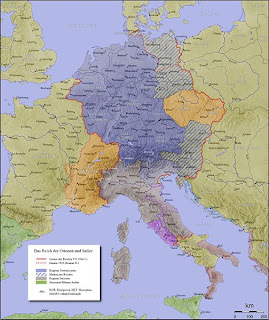If you remember in my last post, I mentioned that King William I became King of Prussia in 1861. In 1862, King William nominated Otto von Bismarck to become the Prime Minister of Prussia. Bismarck was very interested in creating what he felt should be a “united” Germany, which meant the uniting of all Germanic nations into one, but with the stipulation that the Prussian ruling class and bureaucracy should remain dominant.
Up to this time, the German Confederation contained several loosely bound principalities without any one dominating power. It was for this reason that Bismarck found it necessary to form one single power and used both diplomatic and Prussian military means to achieve this objective. He made great efforts to gain the support of not only the bureaucracy, but that of the common folk as well by promising to lead the fight for a final German unification.
It took him three major conflicts to gain this status however, which conclusively led to the ultimate naming of William I as the first German Emperor on 18 January 1871.
The first of these conflicts began with the so-called First War of Schleswig beginning in 1848 and ending in 1851 followed by the Second War of Schleswig from 1863 to 1865. If you look at the map below (click on it to enlarge), you can see area 14 (Schleswig) and 8 (Holstein).
The first of these conflicts began with the so-called First War of Schleswig beginning in 1848 and ending in 1851 followed by the Second War of Schleswig from 1863 to 1865. If you look at the map below (click on it to enlarge), you can see area 14 (Schleswig) and 8 (Holstein).

The Duchies of Schleswig and Holstein were in alliance with the Kingdom of Denmark, whereas the Duchy of Holstein was already part of the German Confederation at that time. The conflict began because Denmark (in the white area marked “Expansion of Prussia”) attempted to annex Schleswig (14) but not Holstein (8) and Prussia decided to intervene by taking both territories for itself. The Danes were defeated but the other European powers attempted to pressure Prussia into returning Schleswig and Holstein to Denmark.
One of these powers was Austria, who was supported by Russia. Because of this, Prussia was persuaded in 1850 to return Schleswig and Holstein to Denmark's control but only if the Danes were not to integrate Schleswig into Denmark.
One of these powers was Austria, who was supported by Russia. Because of this, Prussia was persuaded in 1850 to return Schleswig and Holstein to Denmark's control but only if the Danes were not to integrate Schleswig into Denmark.
In 1863 however, the Danes began once again to attempt an integration of Schleswig by introducing a shared constitution. The German Confederation, led now by the Austrians, saw it necessary to occupy Holstein causing Denmark to withdraw her troops. Denmark continued refusal to give up Schleswig and in 1864, the Prussian and Austrian forces entered Schleswig and thereby initiated the Second War of Schleswig.



























 Buying Nobility - Noble Titles for Sale (GALLERY)
Buying Nobility - Noble Titles for Sale (GALLERY)







